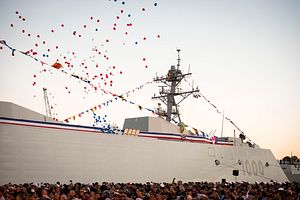The biggest and most technologically advanced destroyer in U.S. naval history, the 16,000-ton next generation guided-missile destroyer USS Zumwalt (DDG 1000), was commissioned into active service at North Locust Point on October 15, according to a U.S. Navy press release.
Secretary of the Navy Ray Mabus delivered the ceremony’s principal address. “This ship is an example of a larger initiative to increase operational stability and give the U.S. a strategic advantage,” said Mabus. “Our Navy and our Marine Corps, uniquely, provide presence – around the globe, around the clock — ensuring stability, reassuring allies, deterring adversaries, and providing the nation’s leaders with options in times of crisis.”
The USS Zumwalt, featuring a wave-piercing tumblehome hull and stealth design, is the lead ship of a class of next-generation multi-mission destroyers. The U.S. Navy is currently constructing two additional Zumwalt-class guided-missile destroyers. According to a U.S. Navy spokesperson, the total procurement cost for the new destroyers includes $3.8 billion for DDG 1000 [USS Zumwalt], $2.8 billion for DDG 1001 [USS Michael Monsoor], and $2.4 billion for DDG 1002 [USS Lyndon B. Johnson].”
“This destroyer, like the others in our fleet, is capable of projecting power, no doubt,” said Mabus. “The Zumwalt-class is much larger than today’s destroyers with a considerably larger flight deck – enough space to operate host Joint Strike Fighters, MV-22 Ospreys, and unmanned systems and a Vertical Launch System second to none.”
The destroyer is equipped with a so-called Peripheral Vertical Launch System with eighty MK57 vertical launch tubes, which can accommodate one to four missiles depending on their size and is armed with a wide range of weapon systems including Tomahawk missiles, torpedoes, and anti-submarine rockets.
Furthermore, “each ship features a battery of two Advanced Gun Systems (AGS) firing Long-Range Land Attack Projectiles (LRLAP) that reach up to 63 nautical miles [72 miles, 115 kilometers], providing a three-fold range improvement in naval surface fires coverage,” according to the U.S. Navy.
The Zumwalt is also the first U.S. Navy warship to use a new integrated power system. The destroyer produces enough “power to run current systems, as well as the power required for future weapons, computing, and sensor systems. Zumwalt generates approximately 78 megawatts of power, almost as much as a nuclear-powered aircraft carrier,” the U.S. Navy explains.
As I noted elsewhere (See: “US Navy’s New Stealth Destroyer Soon to Test Weapon Systems”):
America’s latest surface warship successfully completed builder’s trials in March 2016 and December 2015 in the Atlantic Ocean. It completed inspection and acceptance trials — including rough-weather trials — with the Navy’s Board of Inspection and Survey in April of this year. The ship is slated to achieve initial operating capability in October.
The ship suffered an engineering casualty during preparation for at-sea trials on September 19 (See: “US Navy’s New Stealth Destroyer Suffers Engineering Casualty”). However, repairs at Naval Station Norfolk did not impact the commissioning date.
The USS Zumwalt’s will now be transferred to San Diego, California, where the destroyer’s combat systems will be installed. The Zumwalt will officially join the U.S. Navy’s surface fleet in 2018.
































